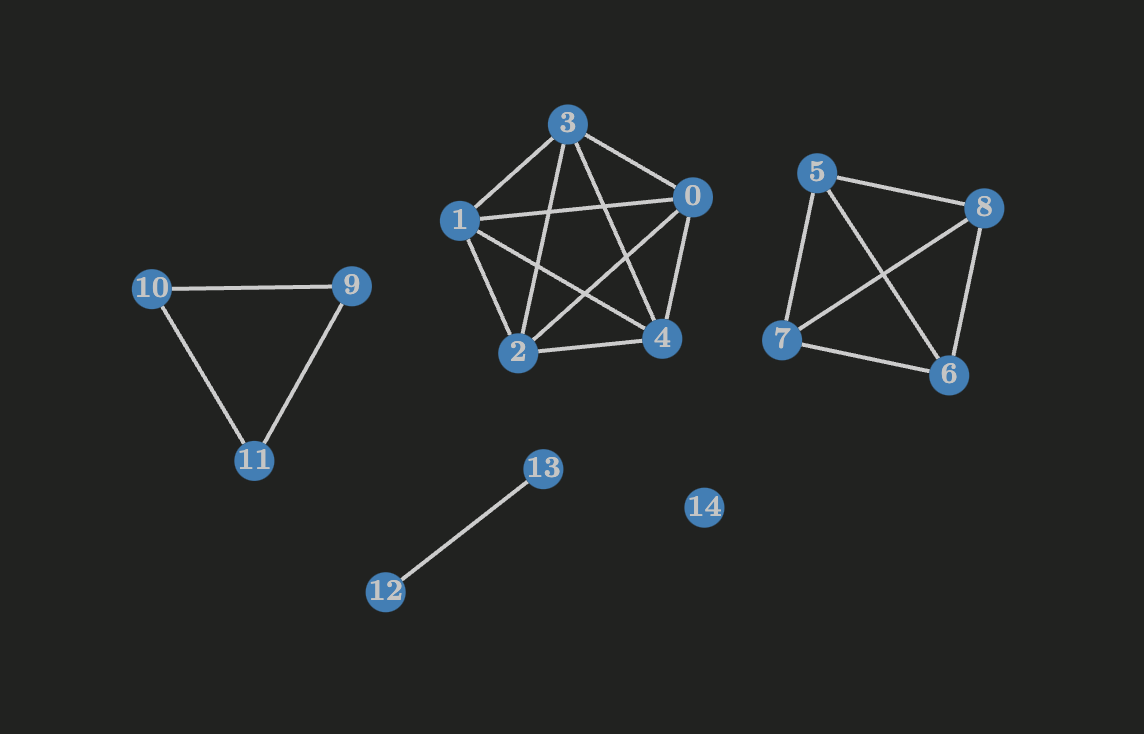Unweighted graph
We call a shortest path from vertex
In an unweighted graph, a breadth-first search guarantees that when we analyze a vertex
- Let
- Whenever a vertex
/**
* Breadth first search algorithm applied on an unweighted graph `G`
* of order `n` and size `m` to find the shortest path from a source
* vertex `s`
*
* Time complexity: O(n + m)
* Space complexity: O(n)
*
* @param {vector<vector<int> >} g The adjacency list representation
* of `G`, each entry `g_{ij}` holds the end `v` of the edge `iv`
* @param {int} s The source vertex
* @return {vector<int>} The shortest path from `s` to all the other vertices
*/
vector<int> bfs(vector<vector<int> > &g, int s) {
int n = g.size();
// the vertex predecessor of `i` in the `s-i` path
vector<int> parent(n, -1);
// holds the shortest distance from `s` to vertex `i`
vector<int> d(n, INF);
// the distance from the source vertex is zero
d[s] = 0;
// accumulated weight, next vertex (weight, v)
queue<int> q;
q.push(s);
while (!q.empty()) {
int v = q.front();
q.pop();
for (int i = 0; i < g[v].size(); i += 1) {
int to = g[v][i];
if (d[to] == INF) {
d[to] = d[v] + 1;
parent[to] = v;
q.push(to);
}
}
}
return d;
}
Weighted graph
Dijkstra’s algorithm
Dijkstra described an algorithm to solve the SSSP. There are some additional states that need to be stored per vertex:
- Let
- Let
The algorithm consists of a series of iterations. In each iteration, let
- The visited state is set to true, i.e.,
- Let
After
We need a data structure that quickly supports the following three operations:
- Remove a vertex with the minimum distance that hasn’t been discovered yet (up to once for each vertex in the graph).
- Add a new vertex (up to once for each vertex in the graph).
- Update the estimated distance of an existing vertex (once for each edge in the graph).
Implementation with an array
An array supports the operations above in
/**
* An implementation of Dijkstra's algorithm which computes
* the shortest path from a source vertex `s` to all the other vertices
* in a graph `G` with `V` vertices and `E` edges.
*
* Time complexity: O(V^2 + E)
* Space complexity: O(V)
*
* @param {vector<vector<pair<int, int> > >} g The adjacency list representation
* of `G`, each entry `g_{ij}` holds the end `v` of the edge `iv` and the weight
* `weight` of the edge i.e. (v, weight)
* @param {int} s The source vertex
* @return {vector<int>} The shortest path from `s` to all the other vertices
*/
vector<int> dijkstra(vector<vector<pair<int, int> > > &g, int s) {
int V = g.size();
int INF = 1e9;
vector<bool> visited(V);
// the vertex predecessor of `i` in the `s-i` path
vector<int> parent(V, -1);
// holds the estimated distance
vector<int> d(V, INF);
// the estimated distance from the source vertex is zero
d[s] = 0;
for (int i = 0; i < V; i += 1) {
// the vertex with the minimum estimated distance
int v = -1;
for (int j = 0; j < V; j += 1) {
// find the vertices which haven't been visited yet
// among them find a vertex with the minimum estimated distance
if (!visited[j] && (v == -1 || d[j] < d[v])) {
v = j;
}
}
if (d[v] == INF) {
// the vertex selected is not reachable from `s`
break;
}
visited[v] = true;
// update the estimated distance from `v`
// to all the other adjacent vertices
for (int j = 0; j < g[v].size(); j += 1) {
pair<int, int> &edge = g[v][j];
int next = edge.first;
int weight = edge.second;
int new_distance = d[v] + weight;
if (new_distance < d[next]) {
d[next] = new_distance;
parent[next] = v;
}
}
}
return d;
}
Implementation with a BST
A balanced search tree supports the operations above in
/**
* C++11
*
* An implementation of Dijkstra's algorithm which computes
* the shortest path from a source vertex `s` to all the other vertices
* in a graph `G` of order `V` and size `E`
*
* Time complexity: O((E+V) log V)
* Space complexity: O(V)
*
* @param {vector<vector<pair<int, int>>>} g The adjacency list representation
* of `G`, each entry `g_{ij}` holds a pair which represents an edge
* (vertex, weight) which tells that there's an edge from `i` to `vertex`
* with weight `weight`
* @param {int} s The source vertex
* @return {vector<int>} The shortest path from `s` to all the other vertices
*/
int dijkstra(vector<vector<pair<int, int>>> &g, int source) {
int V = g.size();
int INF = 1e9;
int total = 0;
// the vertex predecessor of `i` in the `s-i` path
vector<int> parent(V, -1);
// holds the estimated distance
vector<int> d(V, INF);
// the estimated distance from the source vertex is zero
d[s] = 0;
// accumulated weight, next vertex (weight, v)
set<pair<int, int>> q;
q.insert({0, s});
while (!q.empty()) {
pair<int, int> edge = *(q.begin());
int from = edge.second;
q.erase(q.begin());
for (int i = 0; i < g[v].size(); i += 1) {
int to, weight;
// note that in the graph the first element is the neighbor vertex
// but in the set the first element is the edge weight
tie(to, weight) = g[v][i];
if (d[from] + weight < d[to]) {
q.erase({ d[to], to });
d[to] = d[from] + weight;
parent[to] = v;
q.insert({ d[to], to });
}
}
}
return d;
}
Applications
- Find the shortest path between two vertices
- Find the shortest path from all vertices to a given vertex
- Find the shortest path for every pair of vertices


